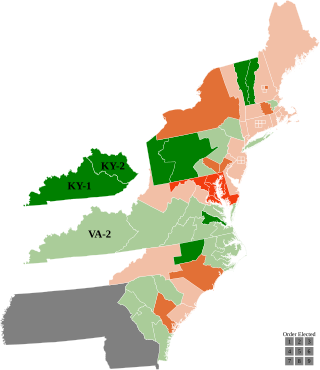These are tables of congressional delegations from New York to the United States House of Representatives and the United States Senate.

These are tables of congressional delegations from Ohio to the United States House of Representatives and the United States Senate.
These are tables of congressional delegations from Vermont to the United States Senate and United States House of Representatives.
These are tables of congressional delegations from Virginia to the United States Senate and United States House of Representatives. Virginia's current U.S. Senators are Democrats Mark Warner and Tim Kaine. Virginia is allotted 11 seats in the U.S. House of Representatives; currently, 6 seats are held by Democrats and 5 seats are held by Republicans.

These are tables of congressional delegations from Maryland in the United States House of Representatives and the United States Senate.

Vermont has been represented in the United States House of Representatives by a single at-large congressional district since the 1930 census, when the state lost its second seat, obsoleting its 1st and 2nd congressional districts. There were once six districts in Vermont, all of which were eliminated after various censuses.

The 1828–29 United States House of Representatives elections were held on various dates in various states between July 9, 1828, and October 5, 1829. Each state set its own date for its elections to the House of Representatives before the first session of the 21st United States Congress convened on December 7, 1829. Elections were held for all 213 seats, representing 24 states.

The 1826–27 United States House of Representatives elections were held on various dates in various states between July 3, 1826, and August 30, 1827. Each state set its own date for its elections to the House of Representatives before the first session of the 20th United States Congress convened on December 3, 1827. They occurred during John Quincy Adams's presidency. Elections were held for all 213 seats, representing 24 states.

The 1824–25 United States House of Representatives elections were held on various dates in various states between July 7, 1824, and August 30, 1825. Each state set its own date for its elections to the House of Representatives before the first session of the 19th United States Congress convened on December 5, 1825. Elections were held for all 213 seats, representing 24 states.

The 1822–23 United States House of Representatives elections were held on various dates in various states between July 1, 1822, and August 14, 1823. Each state set its own date for its elections to the House of Representatives before the first session of the 18th United States Congress convened on December 1, 1823. They occurred during President James Monroe's second term.

The 1792–93 United States House of Representatives elections were held on various dates in various states between August 27, 1792, and September 6, 1793. Each state set its own date for its elections to the House of Representatives before the first session of the 3rd United States Congress convened on December 2, 1793. With the addition of the new state of Kentucky's representatives, and the congressional reapportionment based on the 1790 United States census, the size of the House increased to 105 seats.

The 1790–91 United States House of Representatives elections were held on various dates in various states between April 27, 1790, and October 11, 1791. Each state set its own date for its elections to the House of Representatives before or after the first session of the 2nd United States Congress convened on October 24, 1791. This was the first midterm election cycle, which took place in the middle of President George Washington's first term. The size of the House increased to 67 seats after the new state of Vermont elected its first representatives.
Beginning from its inception into statehood, New Jersey elected its representatives at-large instead of from individual districts. This continued for most years until 1843, with the exception of the years 1799-1801, and 1813-1815 when they were elected in districts. After 1843, New Jersey returned to district representation. Four at-large representatives were elected in 1789 until 1793 when a 5th representative was added. 6 seats were allocated beginning in 1803, continuing until at-large representation ceased in 1843.
From 1793 to 1827 and again from 1829 to 1845, Georgia elected all its Representatives in Congress from a single multi-member at-large congressional district:

The 1824 United States presidential election in Vermont took place between October 26 and December 2, 1824, as part of the 1824 United States presidential election. The state legislature chose seven representatives, or electors to the Electoral College, who voted for President and Vice President.

The 1974 United States Senate election in Vermont took place on November 5, 1974. The incumbent Republican Senator, George Aiken, did not run for re-election to another term in the United States Senate. The Democratic nominee, Patrick Leahy, the state's attorney of Chittenden County, defeated Republican nominee, Rep. Richard W. Mallary, to become Aiken's successor. This election also included Liberty Union Party candidate Bernie Sanders, who won 4.1% of the vote.

The 1994 United States House of Representatives election in Vermont was held on Tuesday, November 8, 1994, to elect the U.S. representative from the state's at-large congressional district. The election coincided with the elections of other federal and state offices, including an election to the U.S. Senate.












